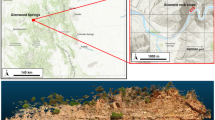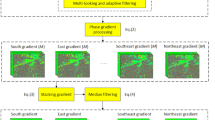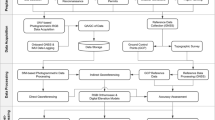Abstract
The Jinsha River flows through one of the most geologically complex regions in western China with extremely high altitudes and capricious climates. Frequent landslides (e.g., the Baige landslides on 11 October and 3 November 2018) occurred along its stretch which posed severe damage to bridges, dams, and roads, and put the safety of local residents at risk. Systematic and comprehensive landslide detection has been rarely carried out in the Jinsha River corridor because it is a wide and hard-to-reach region. With 30 years of development, InSAR has become an effective way to map ground motion, which in turn makes it feasible to detect active landslides over wide regions. However, several challenges remain in applying InSAR in the Jinsha River corridor, such as low coherence due to dense vegetation and/or large gradient surface movements, and atmospheric effects due to the spatio-temporal variations of the atmosphere (especially the part due to tropospheric water vapor). In this paper, we propose a framework to overcome the limitations of conventional InSAR through the integration of GACOS-assisted InSAR, advanced SBAS InSAR, and SAR pixel offset tracking techniques. This integrated framework enables us to detect active landslides under complex topographic and climate conditions. Our results show that the detected active landslides are largely controlled by active faults, most of them are found at elevations of 2500–4000 m, their slopes fall between \(25\) and \(45^\circ\) facing southwest and northwest, and 83.3% of the active landslides have a NDVI value of less than 0.3. Furthermore, precipitation is one critical triggering factor of active landslides, evidenced by the high temporal correlation between average precipitation and surface displacement time series.












Similar content being viewed by others
Change history
04 September 2022
Article was modified to incorporate some corrections in the reference section.
References
Bayer B, Simoni A, Mulas M, Corsini A, Schmidt D (2018) Deformation responses of slow moving landslides to seasonal rainfall in the northern Apennines, measured by InSAR. Geomorphology 308(MAY1):293–306
Behling R, Kleinschmit B, Golovko D, Roessner S (2016) Derivation of long-term spatiotemporal landslide activity-a multi-sensor time series approach. Remote Sens Environ 186:88–104
Berardino P, Fornaro G, Lanari R, Sansosti E (2002) A new algorithm for surface deformation monitoring based on small baseline differential SAR interferograms. IEEE Trans Geosci Remote Sens 40(11):2375–2383
Canuti P, Casagli N, Ermini L, Fanti R, Farina P (2004) Landslide activity as a geoindicator in Italy: significance and new perspectives from remote sensing. Environ Geol 45(7):907–919
Casagli N, Catani F, Ventisette CD, Luzi G (2010) Monitoring, prediction, and early warning using ground-based radar interferometry. Landslides 7(3):291–301
Casu F, Manconi A, Pepe A, Lanari R (2011) Deformation time-series generation in areas characterized by large displacement dynamics: the SAR amplitude pixel-offset SBAS technique. IEEE Trans Geosci Remote Sens 49(7):2752–2763
Colesanti C, Wasowski J (2006) Investigating landslides with space-borne synthetic aperture radar (SAR) interferometry. Eng Geol 88(3–4):173–199
Costantini M (1997) A novel phase unwrapping method based on network programming. IEEE Trans Geosci Remote Sens 36(3):813–821
Crippa C, Valbuzzi E, Frattini P, Crosta GB, Spreafico MC, Agliardi F (2021) Semi-automated regional classification of the style of activity of slow rock-slope deformations using PS InSAR and SqueeSAR velocity data. Landslides 18(7):2445–2463
Cruden DM, Varnes DJ (1996) Landslide types and processes. Special Report - National Research Council, Transportation Research Board 247:36–75
Dai K, Li Z*, Xu Q, Burgmann R, Milledge D, Tomas R, Fan X, Zhao C, Liu X, Peng J, Zhang Q, Wang Z, Qu T, He C, Li D, Liu J (2020) Entering the era of Earth observation-based landslide warning systems. IEEE Geoscience and Remote Sensing Magazine 8(1):136 – 153
Dai K, Zhang L, Song C, Li Z, Zhuo G, Xu Q (2021) Quantitative analysis of Sentinel⁃1 imagery geometric distortion and their suitability along Sichuan⁃Tibet railway. Geomatics and Information Science of Wuhan University 46(10):1450–1460 (In Chinese)
Dou F, Lv X, Chai H (2021) Mitigating atmospheric effects in InSAR stacking based on ensemble forecasting with a numerical weather prediction model. Remote Sensing 13(22):4670. https://doi.org/10.3390/rs13224670
Fan X, Xu Q, Alonso-Rodriguez A, Subramanian S, Li W, Zheng G, Dong X, Huang R (2019) Successive landsliding and damming of the Jinsha River in eastern Tibet, China: prime investigation, early warning, and emergency response. Landslides 16(5):1003–1020
Feng W, Li Z, Elliott JR, Fukushima Y, Hoey T, Singleton A, Cook R, Xu Z (2013) The 2011 Mw 6.8 Burma earthquake: fault constraints provided by multiple SAR techniques. Geophys J Int 195(1):650–660
Ferretti A, Prati C, Rocca F (2001) Permanent scatterers in SAR interferometry. IEEE Trans Geosci Remote Sens 39(1):8–20
Goldstein RM, Werner CL (1998) Radar interferogram filtering for geophysical applications. Geophys Res Lett 25:4035–4038
Gong W, Meyer FJ, Liu S, Hanssen RF (2015) Temporal filtering of InSAR data using statistical parameters from NWP models. IEEE Trans Geosci Remote Sens 53(7):4033–4044
Guo C, Yan Y, Zhang Y, Zhang X, Zheng Y, Li X, Yang Z, Wu R (2021) Study on the creep-sliding mechanism of the giant Xiongba ancient landslide based on the SBAS-InSAR method, Tibetan Plateau. China Remote Sensing 13(17):3365. https://doi.org/10.3390/rs13173365
Guzzetti F, Mondini AC, Cardinali M, Fiorucci F, Santangelo M, Chang KT (2012) Landslide inventory maps: new tools for an old problem. Earth Sci Rev 112(1–2):42–66
Highland LM, Bobrowsky P (2008) The landslide handbook-a guide to understanding landslides. Reston, Virginia, U.S. Geological Survey Circular 1325. p 129
Huang L, Li Z (2011) Comparison of SAR and optical data in deriving glacier velocity with feature tracking. Int J Remote Sens 32(9–10):2681–2698
Jain S, Khosa R, Gosain AK (2022) Impact of landslide size and settings on landslide scaling relationship: a study from the Himalayan regions of India. Landslides 19(2):373–385
Li Z, Elliott JR, Feng W, Jackson JA, Parsons BE, Walters RJ (2011) The 2010 Mw 6.8 Yushu (Qinghai, China) earthquake: constraints provided by InSAR and body wave seismology. J Geophys Res Solid Earth 116(B10):B10302
Li Z, Fielding EJ, Cross P (2009) Integration of InSAR time-series analysis and water-vapor correction for mapping postseismic motion after the 2003 Bam (Iran) earthquake. IEEE Trans Geosci Remote Sens 47(9):3220–3230
Li Z, Fielding EJ, Cross P, Muller JP (2006) Interferometric synthetic aperture radar atmospheric correction: GPS topography-dependent turbulence model. J Geophys Res Solid Earth 111:B02404
Li Z, Song C, Yu C, Xiao R, Chen L, Luo H, Dai K, Ge D, Ding Y, Zhang Y, Zhang Q (2019) Application of satellite radar remote sensing to landslide detection and monitoring: challenges and solutions. Geomatics and Information Science of Wuhan University 44(7):967–979 (In Chinese)
Li Z, Zhang C, Chen B, Zhan J, Ding M, Lv Y, Li X, Peng J (2022) A technical framework of landslide prevention based on multi-source remote sensing and its engineering application. Earth Sci 47(6):1901–1916 (In Chinese)
Liao M, Tang J, Wang T, Balz T, Zhang L (2012) Landslide monitoring with high-resolution SAR data in the Three Gorges region. China Earth SCI 42(2):217–229
Liu X, Zhao C, Zhang Q, Lu Z, Li Z, Yang C, Zhu W, Liu-Zeng J, Chen L, Liu C (2021) Integration of Sentinel-1 and ALOS/PALSAR-2 SAR datasets for mapping active landslides along the Jinsha River corridor. China Engineering Geology 284:106033
Lu H, Li W, Xu Q, Dong X, Dai C, Wang D (2019) Early detection of landslides in the upstream and downstream areas of the Baige landslide, the Jinsha River based on optical remote sensing and InSAR technologies. Geomatics and Information Science of Wuhan University 44(9):1342–1354 (In Chinese)
Lu L, Wang Q, Wang GQ, Liu YL, Liu CS (2016) Trend of climate change over the recent 60 years and its hydrological responses for Jinsha river basin. Journal of North China University of Water Resources and Electric Power (natural Science Edition) 37(05):16–21 (In Chinese)
Martha TR, Kerle N, Jetten V, Westen C, Kumar KV (2010) Characterising spectral, spatial and morphometric properties of landslides for semi-automatic detection using object-oriented methods. Geomorphology 116(1–2):24–36
Massonnet D, Feigl KL (1998) Radar interferometry and its application to changes in the Earth’s surface. Rev Geophys 36(4):441–500
Metternicht G, Hurni L, Gogu R (2005) Remote sensing of landslides: an analysis of the potential contribution to geo-spatial systems for hazard assessment in mountainous environments. Remote Sens Environ 98(2–3):284–303
Ouyang CJ, Zhao W, Xu Q, Peng DL, Li WL, Wang DP, Zhou S, Hou SW (2018) Failure mechanisms and characteristics of the 2016 catastrophic rockslide at Su village, Lishui. China Landslides 15(7):1391–1400
Pathier E, Fielding EJ, Wright TJ, Walker R, Parson BE, Hensley S (2006) Displacement field and slip distribution of the 2005 Kashmir earthquake from SAR imagery. Geophys Res Lett 33:L20310
Paulin GL, Mickelson KA, Contreras TA, Gallin W, Jacobacci KE, Bursik M (2022) Assessing landslide volume using two generic models: application to landslides in Whatcom County, Washington, USA. Landslides 19(4):901–912
Pepe A, Lanari R (2006) On the extension of the minimum cost flow algorithm for phase unwrapping of multitemporal differential SAR interferograms. IEEE Trans Geosci Remote Sens 44:2374–2383. https://doi.org/10.1109/TGRS.2006.873207
Ran YH, Li X, Cheng GD, Zhang TJ, Wu QB, Jin HJ, Jin R (2012) Distribution of permafrost in China: an overview of existing permafrost maps. Permafrost Periglac Process 23(4):322–333
Riddick SN, Schmidt DA, Deligne NI (2012) An analysis of terrain properties and the location of surface scatterers from persistent scatterer interferometry. ISPRS J Photogramm Remote Sens 73(SEP.):50–57
Rosi A, Tofani V, Tanteri L, Tacconi Stefanelli C, Agostini A, Catani F, Casagli N (2018) The new landslide inventory of Tuscany (Italy) updated with PS-InSAR: geomorphological features and landslide distribution. Landslides 15(1):5–19
Sassa K (2004) The international consortium on landslides. Landslides 1(1):91–94
Shi X, Zhang L, Balz T, Liao M (2015) Landslide deformation monitoring using point-like target offset tracking with multi-mode high-resolution TerraSAR-X data. ISPRS J Photogramm Remote Sens 105(Jul.):128–140
Singleton A, Li Z, Hoey T, Muller JP (2014) Evaluating sub-pixel offset techniques as an alternative to D-InSAR for monitoring episodic landslide movements in vegetated terrain. Remote Sens Environ 147:133–144
Sun Q, Zhang L, Ding X, Hu J, Li Z, Zhu J (2015) Slope deformation prior to Zhouqu, china landslide from InSAR time series analysis. Remote Sens Environ 156:45–57
Squarzoni G, Bayer B, Franceschini S, Simoni A (2020) Pre and post failure dynamics of landslides in the northern Apennines revealed by space-borne synthetic aperture radar interferometry (InSAR). Geomorphology 369:107353
Tofani V, Segoni S, Agostini A, Catani F, Casagli N (2013) Technical note: use of remote sensing for landslide studies in Europe. Natural Hazards and Earth System Science 13(2):299–309
Westen CJV, Castellanos E, Kuriakose SL (2008) Spatial data for landslide susceptibility, hazard, and vulnerability assessment: an overview. Eng Geol 102(3–4):112–131
Wegmüller U, Werner C, Strozzi T, Wiesmann A, Santoro M (2015) Sentinel-1 support in the GAMMA software. Fringe 100:1305–1312
Xiao R, Yu C, Li Z, He X (2021) Statistical assessment metrics for InSAR atmospheric correction: applications to generic atmospheric correction online service for InSAR (GACOS) in Eastern China. Int J Appl Earth Obs Geoinf 96:102289
Xiao R, Yu C, Li Z, Song C, He X (2020) General survey of large-scale land subsidence by GACOS-corrected InSAR stacking: case study in North China Plain. Proceedings of the International Association of Hydrological Sciences 382:213–218
Xu Q, Zheng G, Li W, He C, Dong X, Guo C, Feng W (2018) Study on successive landslide damming events of Jinsha River in Baige village of Octorber 11 and November 3, 2018. J Eng Geol 26(6):1534–1551 (In Chinese)
Xu Q, Dong X, Li W (2019) Integrated space-air-ground early detection, monitoring and warning system for potential catastrophic landslides. Geomatics and Information Science of Wuhan University 44(7):957–966 (In Chinese)
Xu Q, Peng D, Zhang S, Zhu X, He C, Qi X, Zhao K, Xiu D, Ju N (2020a) Successful implementations of a real-time and intelligent early warning system for loess landslides on the Heifangtai terrace, China – ScienceDirect. Eng Geol 278:105817
Xu Q (2020b) Understanding and consideration of related issues in early identification of potential geohazards. Geomatics and Information Science of Wuhan University 45(11):1651–1659 (In Chinese)
Xu W, Zhang Q, Zhang J, Wang R (2013) Deformation and control engineering related to huge landslide on left bank of Xiluodu reservoir, south-west China. Eur J Environ Civ Eng 17:249–268
Xu X, Han Z, Yang X, Zhang S, Yu G, Zhou B, Li F, Ma B, Chen G, Ran Y (2016) Seismotectonic map of China and adjacent areas. Earthquake Press. Data, Beijing. https://doi.org/10.12031/activefault.china.250.2016.db (In Chinese)
Yao X, Deng J, Liu X, Zhou Z, Yao J, Dai F, Ren K, Li L (2020) Primary recognition of active landslides and development rule analysis for Pan Three-river-parallel Territory of Tibet Plateau. Advanced Engineering Sciences 52(5):16–37 (In Chinese)
Ye X, Kaufmann H, Guo X (2004) Landslide monitoring in the Three Gorges Area using D-INSAR and corner reflectors. Photogramm Eng Remote Sens 70(10):1167–1172
Yu C, Li Z, Penna NT (2018a) Interferometric synthetic aperture radar atmospheric correction using a GPS-based iterative tropospheric decomposition model. Remote Sens Environ 204:109–121
Yu C, Li Z, Penna NT, Paola C (2018b) Generic atmospheric correction model for Interferometric Synthetic Aperture Radar observations. Journal of Geophysical Research: Solid Earth 123(10):9202–9222
Yu C, Li Z, Penna NT (2020) Triggered after slip on the southern Hikurangi subduction interface following the 2016 Kaikōura earthquake from InSAR time series with atmospheric corrections. Remote Sens Environ 251(251):112097
Yu C, Penna NT, Li Z (2017) Generation of real-time mode high-resolution water vapor fields from GPS observations. Journal of Geophysical Research: Atmospheres 122(3):2008–2025
Zhang C, Li Z, Yu C, Song C, Xiao R, Peng J (2021) Landslide detection of the Jinsha River region using GACOS assisted InSAR stacking. Geomatics and Information Science of Wuhan University 46(11):1649–1657 (In Chinese)
Zhang L, Liao M, Dong J, Xu Q, Gong J (2018) Early detection of landslide hazards in mountainous areas of west China using time series SAR interferometry-a case study of Danba, Sichuan. Geomatics and Information Science of Wuhan University 43(12):2039–2049 (In Chinese)
Zhang L, Xiao T, He J, Chen C (2019) Erosion-based analysis of breaching of Baige landslide dams on the Jinsha River, China, in 2018. Landslides 16(10):1965–1979
Zhu J, Li Z, Hu J (2017) Reasearch progress and methods of InSAR for deformation monitoring. Acta Geodaetica ET Cartographica Sinica 46(10):1717–1733
Zhu Y, Qiu H, Yang D, Liu Z, Ma S, Pei Y, He J, Du C, Sun H (2021) Pre- and post-failure spatiotemporal evolution of loess landslides: a case study of the Jiangou landslide in Ledu, China. Landslides (8)
Zhu Q, Zeng H, Ding Y, Xie X, Liu F, Zhang L, Li H, Hu H, Zhang J, Chen L, Chen L, Zhang P, He H (2019) A review of major potential landslide hazards analysis. Acta Geodaetica Et Cartographica Sinica 48(12):1551–1561
Zhuang J, Jia K, Zhan J, Zhang C, Kong J, Du C, Wang S, Cao Y, Peng J (2022) Scenario simulation of the landslide dynamic process of large-scale landslides: a case study of the Xiaomojiu landslide along the Jinsha River. Nat Hazards. https://doi.org/10.1007/s11069-022-05229-7
Zhuang J, Peng J, Wang G, Javed J, Wang Y, Li W (2018) Distribution and characteristics of landslide in Loess Plateau: a case study in Shaanxi province. Eng Geol 236:89–96
Acknowledgements
Thanks to the European Space Agency (ESA) for the Sentinel-1 and Sentinel-2 images, Google Earth for the optical images, National Aeronautics and Space Administration (NASA) and National Mapping Authority (NIMA) for SRTM DEM, Deutsches Zentrum für Luft- und Raumfahrt (DLR) for TanDEM DEM, USGS for the earthquake catalog and China Geological Survey for fault data. The monthly precipitation data was from the Global Precipitation Measurement (GPM, https://gpm.nasa.gov).
Funding
This work was supported by the National Natural Science Foundation of China (41941019). Part of this work was also supported by the Shaanxi Province Science and Technology Innovation team (Ref. 2021TD-51), the Shaanxi Province Geoscience Big Data and Geohazard Prevention Innovation Team (2022), and the Fundamental Research Funds for the Central Universities, CHD (Ref. 300102260301, 300102262902, 300102261108, and 300203211261).
Author information
Authors and Affiliations
Contributions
C. Zhang: InSAR data processing, methodology, result analysis, writing/editing original draft. Z. Li: Concept, supervision, resources, research structure design, result analysis, writing/editing original draft, project administration; C. Yu: Result analysis, reviewing/editing draft; B. Chen, Z. Liu and J. Yang: Field Investigation; M. Ding and J. Peng: Result analysis, reviewing draft.
Corresponding author
Ethics declarations
Competing interests
The authors declare no competing interests.
Appendix
Rights and permissions
Springer Nature or its licensor holds exclusive rights to this article under a publishing agreement with the author(s) or other rightsholder(s); author self-archiving of the accepted manuscript version of this article is solely governed by the terms of such publishing agreement and applicable law.
About this article
Cite this article
Zhang, C., Li, Z., Yu, C. et al. An integrated framework for wide-area active landslide detection with InSAR observations and SAR pixel offsets. Landslides 19, 2905–2923 (2022). https://doi.org/10.1007/s10346-022-01954-z
Received:
Accepted:
Published:
Issue Date:
DOI: https://doi.org/10.1007/s10346-022-01954-z





